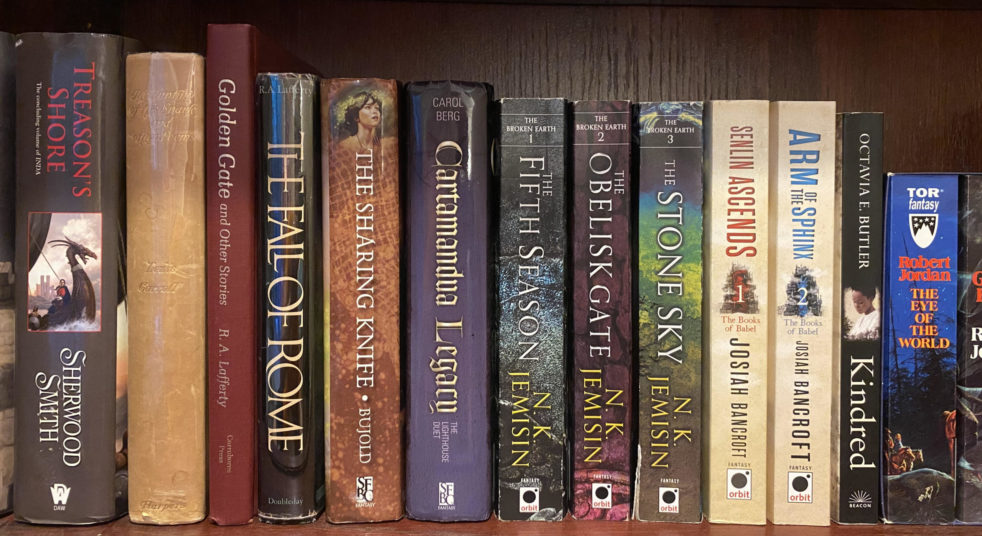It’s been a busy June, with travel, the end of SPSFC, and Hugo Readalong in full swing, but I still managed to get through my two usual magazines, even if it’s later than usual. Let’s take a look!
Clarkesworld
I don’t know that the June issue of Clarkesworld had one story that really stood out above the rest, but it was a quality issue with several stories that I liked a whole lot.
That quality started right from the get-go with Twenty-Four Hours by H.H. Pak, which tells of the final twenty-four hours in which a military researcher is able to visit her mother. It’s an arresting story of complicated relationships, slowly building from mundane interactions into something much deeper. There are a few candidates, but this may be my favorite story in the whole issue.
Our Chatbots Said “I Love You,” Shall We Meet by Caroline M. Yoachim takes place in a near future setting in which family text threads are replaced by curated conversations with AI interlocutors trained on family members and censored to avoid the sorest of subjects. The lead isn’t entirely convinced by a dating app featuring thousands of simulated conversations between chatbots in order to predict compatibility between potential romantic partners, but when she finally hits on a match, she’s forced to decide whether she’s comfortable following through with a real-life meeting. It’s a premise that feels like it could easily be written as dystopian, but instead, the story takes a middle ground, describing something that could just be ordinary life in such a scenario, with a healthy dose of AI skepticism but a lead that’s trying to make the best of a world that might not be the one she suspects is best. This isn’t a tale to drop a hammer, but it’s a fascinating, small-scale exploration of a science fictional way ordinary life could be.
Artistic Encounters of a Monumental Nature by S.B. Divya harkens back to the classic sci-fi trope of a mysterious object appearing with no warning or explanation. In this case, it throws a famous pseudonymous graffiti artist right in the middle of the mystery, one that plays out in a way that’s interesting but perhaps not especially surprising.
If there was one story in the June issue that didn’t really click for me, it was unfortunately the longest of the bunch, the novelette The Reflection of Sand by Tan Gang, translated by Emily Jin. It’s something of a philosophical sci-fi, with lots of reflection on meaning and identity. For much of the story, those reflections are centered specifically on cultural artifacts, as the Mogao Caves are mobilized and divorced from their original surroundings, but it moves into the uploading of consciousness and the formation of digitized collective consciousness. There’s a lot here, even if the throughline didn’t necessarily have me riveted.
The issue’s other novelette, Himalia by Carrie Vaughn, is much more my speed, as a specialist in video documentation returns to the tiny moon base where she was raised in order to witness its decommissioning. But upon arrival, the documentary work takes a backseat to searching for her childhood best friend, who has fled the primary residential areas when faced with the prospect of leaving the only home she’s ever known. It’s a small-scale, personal story about friendship and contrasting feelings about home—just the sort of thing I love to read—and it’s executed to the high level I’ve come to expect from Vaughn.
Bodies by Cat McMahan is another story that hits the theme hard, featuring clones muddling through a thankless, low-paying job while dealing with prejudice and dehumanization from the population around them. This isn’t a story that will grab you on the basis of plot alone, but the depictions of dehumanization are chilling and worth a read on those grounds alone.
Finally, Off Track by Luc Diamant is a short, amusing piece about an over-the-top high school protest after a student is excluded from athletic competition on the grounds that his body gives him an unfair advantage. It’s not long enough to really dig into the fraught considerations surrounding fairness in sports, but it’s without a doubt the most fun read in this month’s issue.
This month’s editorial considers marketing short genre fiction, including Clarke posting a call for expertise in helping Clarkesworld try to level up its own marketing. If you’re in the field, shoot him a message! There’s also an exploration of dreaming, both in how it’s used in genre fiction, the state of current research into dreaming, and potential questions that may arise as science changes how we understand and relate to our dreams.
The interviews this month were all with authors whose books don’t seem exactly up my alley, but I came out of both much more intrigued than I had been previously. Suyi Davies Okungbowa talks about the ideas behind the futuristic thriller Lost Ark Dreaming, while coauthors Dave Klecha and Tobias S. Buckell talk about their new release comic fantasy The Runes of Engagement, in which a group of Marines arrive through a portal into Generic Fantasyland and have to find a way to grind through low-level quests until they can accomplish their primary mission.
GigaNotoSaurus
This month’s long story in GigaNotoSaurus is the short story Underdragon by Diana Dima, one that takes the familiar “unsuspecting tourist purchases a definitely-magical potion from a strange shop, to dramatic results” trope and builds an entire story around it. Such stories seem to more often be interludes in larger works of fantasy, but this one drives an entire tale of transformation and the way it casts one’s entire life into a new light, from relationships to artistic endeavors.
